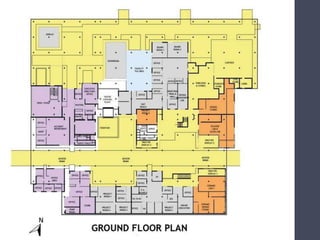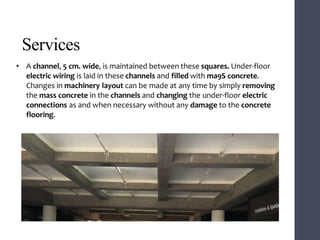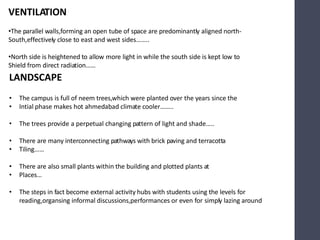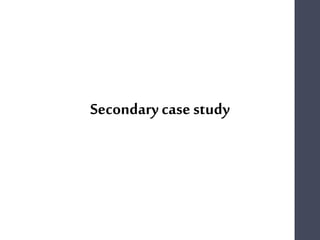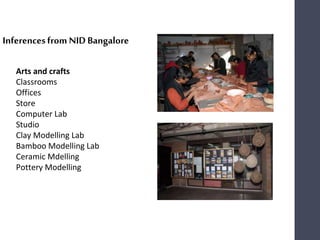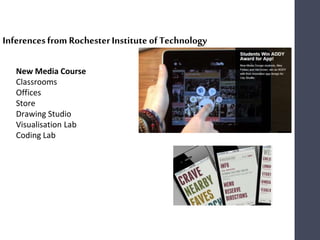Nid & CEPT ahmedabad primary case study
- 1. CASE STUDY Group- Yash Kotgirwar Dhananjay Naik Surdeep Mahanta Arbind Pradhan Auroshree Panda Harsha Reddy Prateek Malakar
- 2. • National Institute of Design was established in Ahmedabad in1961by the Government of as an autonomous national institution for advanced training, research and service in product design, visual communication, architecture, structure planning and allied fields. Area: 63,848 sq.m Architect: Giraben Sarabhai & Charle Eames Overview
- 3. • National Institute of Design (NID) is a design school in Paldi, Ahmedabad ,Gujarat . • Area of the site: 20 acres approx. • The site is located along the Sabarmati River. The site measures about 20 acres. In its surrounding is the Tagore hall, the kite museum and opposite to the site is Diwan Ballabhai high school. • Main Access of the site is from the main road. LOCATION
- 4. Site plan National Institute of Design It is an autonomous institution under the aegis of the Ministry of Commerce and Industry. MASSING OF SITE PLAN MAIN BUILDING-15000 sq.m RESIDENTIAL ZONE-34770 sq.m EDUCATIONAL ZONE-29078sq.m SERVICES-1985sq.m RECREATION HOSTEL-7174sq.m STAFF QTRS SECURITY/ OFFICE PARKING ENTRY-3 nos. residential 2400 sqm administration 400 sqm academic block 4200 sqm SCALE Main building Residential zone educational zone QUANTITY SITE AREA: 63,848 sq.m TOTAL BUILT-UP AREA: 27,488 sq.m FSI: 0.4 N ZONING
- 5. SitePlanning • The whole campus can be distinctively divided into two major zones – Institutional &Residential. The main block which consists both the academic and administration departments is placed on the eastern part facing the river. Sports facilities are in between the two blocks.
- 7. Internalzoning • The courtyards, functionally conceived as open spaces to segregate between two diverse functions of 'seminar rooms' or 'classrooms' and 'workshops' or 'laboratories' due to noise and structural reasons; spatially created light wells for the dark ground spaces. • The north-south orientation of the studios gives more light and cuts off the glare.
- 8. • Emphasis has been given on the pedestrian movement of the site. • Vehicular movement is restricted only till the entrance for the visitors. But it is possible from residential areas to academic block and vice- versa. • Besides, service entries are provided for the various workshops. • Horizontal circulation: The movement pattern develops on the ground floor through the court like spaces that developed under the structural grid. • One is made to experience the receding columns in perspective on the way to canteen. The main circulation on the first & second floors is through a long and narrow passage at the centre. The passage is single height narrow linear space. Circulation
- 12. • It is by triple height staircase marked with platforms at different levels which gives a very impactful experience. One of its major functions is to formalize the entry to auditorium on the second floor. The second staircase has been placed in the rear most court, which is used as secondary preference to the triple height staircase. Spiral stairs have been provided as a means of connecting workshop to the studios. The semi opened space around the canopied roof of the double staircase is an excellent activity area where the students interact, relax and has some major source of exchange of ideas. Vertical Circulation
- 13. • Grid planning: The plan of NID signifies varied spatial experiences with different 'spatial types' such as the pen courtyard with thorough way, the raised platform type, the colonnade type facing the green spaces, the multiple entrances, the formal entrance court with the brick shell, and lastly the grid which holds the whole composition together. • The plan displays magnificent interconnections and spatial non- hierarchy with the openness of the organization. The complex modulations with partition walls, created maze with diverse experiences. This openness of the plan symbolizes the expression - 'free plan'. • Another interesting juxtaposition is the location of an old monument, used as backdrop for amphitheatre, in close vicinity to the main building. The existence of old and the new, creates dynamic compositional balance. Structuredetails
- 14. •As soon as the built form is placed on site it generates its own space in and around it. Thus the outside open spaces are as much important a design criteria as inner • Lawns are used for informal gathering, cultural program, etc. •The campus has been completely landscaped. Three platforms extend from the institute building in the lawn acting as built-in sit outs. •There is also an ancient monument and open air amphitheatre having densely planted trees around it. •Amphitheatre is also used for social functions, fashion shows, etc. • Lawns are not only a feature of landscape but they act as interactive spaces. LANDSCAPE
- 15. • Precast concrete is a construction product produced by casting concrete in a reusable mold or "form" which is then cured in a controlled environment, transported to the construction site and lifted into place. • Precast concrete production is performed on ground level, which helps with safety throughout a project. There is greater control over material quality and workmanship in a precast plant compared to a construction site. The forms used in a precast plant can be reused hundreds to thousands of times before they have to be replaced, often making it cheaper than onsite casting when looking at the cost per unit of formwork. Construction Technology
- 16. Materials • Precast RCC shells are designed to carry machine loads of 1000kg/sq. metre (including impact). • The first few shells were of reinforced reinforced cement concrete, but the next step was to develop them of reinforced brick with an RCC band at the edges. • In the third stage, the entire shell was made of reinforced brick. The final stage of the development was the design of a brick shell without any reinforcement at all. • Flooring consists of squares of two module length, cast in situ cement (patent stone).
- 17. • The campus has been designed taking into consideration the hot and dry climate of Ahmedabad. The activities are so planned that they spill over into inward looking spaces. • The courtyards remain in the shadow for most part of the day. To allow the inflow of light into the workshops, sliding panels have been installed which run from the height of the skirting to about 10’ from the floor level. • Pockets of vegetation blend with the structure on the exterior as well as interior. Large trees protect the building from surface glazing and courtyards from excessive heating. • The external cladding is prefabricated and consists of heat resisting glass in metal frames in workshops and in rosewood frame in studios. • Winds from the riverside are captured in the studios and workshops from the terraces due to adjustable glazing. Features like water bodies with jallis are used to filter the cooled air flowing over the water and passed in interiors. LightingandVentilation
- 18. Services • A channel, 5 cm. wide, is maintained between these squares. Under-floor electric wiring is laid in these channels and filled with ma9S concrete. Changes in machinery layout can be made at any time by simply removing the mass concrete in the channels and changing the under-floor electric connections as and when necessary without any damage to the concrete flooring.
- 19. • Ducts for housing various services like water pipes, electric cables, ventilation and air- conditioning are an integral part of the design of the building.
- 20. Modifications • Office space - workshop area. • First floor mezzanine
- 22. OtherFeatures
- 23. DRAMATICS OF LIGHT AND SHADOW DESIGN STREET
- 24. GREEN BELT ON THE EASTERN FAÇADE TO HAVE GLARE- FREE MORNING LIGHT IN THE WORK SPACES NATURALLY SHADED PATHWAYS
- 25. SHADED PATHWAY VIZ PIGEON PARK LEADING TO NID FROM HOSTEL BLOCK PANAROMIC VIEW OF THE OPEN AIR AMPHITHEATRE
- 26. CASE STUDY Centre for Environmental Planning and Technology(CEPT) Ahmedabad
- 28. APPROACH • Main access on the northern side • Two entrances on the southern side which is an internal access two entrances on the western side SITE • The site is located in the Kasturi Bhai lalbhai campus in • Navarangapura,Ahmedabad, Gujarat • It lies within a zone occupied by other educational institutions • This CEPT university is located at the edge of the educational zone,so it is close to other residential zone. TOPOGRAPHY The general slope is towards the north western corner
- 29. ARCHITECTS PHILOSOPHY • Elimination of classroom feeling • Architecture without barriers • Integration of open spaces • Ease of interaction between various departments • FEATURES • The building is set back 100ft from the main road and is covered by trees to create the • Cool atmosphere inside the campus and is hardly visible from the main road… • Creation of a proper working environent facilitating faculty and students to have • Free scope to learn and teach anywhere……. • Exposed local materials for low cost,easy expansion and maintaince….. • The design is intended to be close to nature and experiment the designing skills,play • With,levels etc..,The site was undulated and gave oppurtunity to play with levels…… • There are incline skylights on top of the studios,perpetually letting in natural light • Into the spaces….. • The studio spaces have bay spaces facing the exterior,creating semi-private spaces which are yet totally open to the exterior spaces where the individual can be alone with nature even in the environment of a studio…..
- 30. LEVEL – 1 FLOOR PLAN LEVEL – 1 FA101 - M.ARCH LANDSCAPE STUDIO FP 102 – M.PLAN 1ST YEAR FP102 – M.PLAN 1ST YEAR UN101 – AUDITORIUM UN102 – LIBRARY EXPANSION UN103 – SERVER ROOM UN104 – COMPUTER LAB UN105 - STUDIO
- 31. LEVEL – 2 FLOOR PLAN FA201 – B.ARCH 2ND YEAR STUDIO FA202 – M.ARCH SPECILIZATION FA203 – M.ARCH 1ST YEAR STUDIO FA204 – M.ARCH 2ND YEAR STUDIO FP201 – M.PLAN 2ND YEAR FP202 – M.PLAN 2ND YEAR UN201 – CUE UN202 – LIBRARY UN203 – ADMIN AREA UN204 – RECEPTION UN205 – ELECTRICITY ROOM UN206 - PRESIDENT CABIN UN207-UN222- FACULTY CABIN UN223 – MEETING ROOM UN226 – TEACHING ASSISTANT CABIN UN227 – IT NODE&FACULTY COPIER
- 32. LEVEL – 3 FLOOR PLAN FA301 – B.ARCH 4TH YEAR STUDIO FA302 – B.ARCH3RDYEAR STUDIO FA303 – B.ARCH 1ST YEAR STUDIO FP301 – M.PLAN 2NDYEAR RPM FP302 – M.PLAN 2NDYEAR EP FP303 – B.PLAN 1ST YEAR FM301 – FM STUDIO UN301 – SEMINAR ROOM UN302 – LIBRARY UN303 -UN323 – FACULTY CABINS UN324 – EMPTY ROOM UN325 – EMPTY ROOM
- 33. PLANNING • The built form starts with a pair of parallel walls.The basic component of the buildings of the cept is a derivate of load-bearing walls,supporting a flat floor slabs.The repeated occurrence of parallel walled structues can be seen in the cept campus…… • The overall planning has been done around the central court with built masses on sides and green on one side which gives the campus noise protection……… • The whole building is very simple and architectural elements are • Expressive of their functions…. • The spaces created by volumes and voids are visually exciting…. • The building has simple horizontal lines and merges beautifully • With the site…… • The building is two-storyed with a split level basement…….. • The building design incorporates the thermal comfort and • Natural sensibly….
- 34. BASEMENT The basement is a multi-purpose space.It is a very active spaces of the campus.On one side of the basement rising contours can be seen,and on the other side steps towards the central courtyard…. Thus the north and south walls have been avoided.Numerous activities are performed here like cultural programs,fests and exhibitions,indoor games etc..,
- 35. CENTRAL COURTYARD The central court yard is a combination of paved and unpaved areas,shaded by Trees in certain areas…. All entrances are linked to the courtyard by pedestrain pathways…….. Hence the courtyard is an area of heavy circulation of interaction……. STUDIOS • The studios have large openings which open into the greenary outside…… • Panels at the sides help the students to put up the important and useful • Sheets…. • All the studios are above one another,along with the adjacent lecture • Rooms…….. • There are common interaction zones between the studios of different • Years………. • The studios are designed keeping in mind the climatic needs and comfort • Of its users….. • The building section and double height studios are well conceived to • Facilitate air flow…… • The building is oriented along the east-west axis with openings on north&south and thickwalls are provided on the east and west to keep off the hot sun
- 37. VENTILATION •The parallel walls,forming an open tube of space are predominantly aligned north- South,effectively close to east and west sides…….. •North side is heightened to allow more light in while the south side is kept low to Shield from direct radiation…… LANDSCAPE • The campus is full of neem trees,which were planted over the years since the • Intial phase makes hot ahmedabad climate cooler…….. • The trees provide a perpetual changing pattern of light and shade….. • There are many interconnecting pathways with brick paving and terracotta • Tiling…… • There are also small plants within the building and plotted plants at • Places… • The steps in fact become external activity hubs with students using the levels for reading,organsing informal discussions,performances or even for simply lazing around
- 38. DESIGN FEATURES • All buildings are oriented in the north-south direction……. • Open spaces on the north and south side respectively allow fresh air to ventilate the built structures • The open spaces and the shaded once merge with the landscape………. • The open spaces is linked to the office and library area workshop and • Canteen….. • The areas are very lively and dynamic……….
- 39. Students had done the art works from the scrap which is left over in the college.....These are changed periodically.....
- 40. Measurements are encrypted on the beam while in the time of construction Jalis made with wood can be seen in the walls of cept university
- 41. o Product Design • Studio • Material sample library • Drawing stu9dio • Classroom(2) • Office • Visiting faculty • Project studio + office • Ergonomic studio + office o Ceramic & Glass Design • Ceramic labs(1) • Ceramic Design studio • Plaster and glass lab • Furnace lab • Prototype display • Faculty cubicles • Graphics/visual Design • Design studio • Film video communication studio • Visiting faculty • office • Film & video communication o Photo studio o Fim and video lab o Animation camera room o Slide room o Preview room o Photo store o Store o Classroom o A.V. Store o QR lab o Dark room o Offices
- 42. o Animation Film design • A.V & resource centre • Digital documentation centre • Computer studio • Layout and plate making studio • Dark room • Offset printing • Printing lab • Printing store • Leather • New media • Editing room • Camera room • Sound room • Store • VMP editing room • Classroom • offices o Exhibition Design • Studio • Claasroom • Store • Office o Textile Design • Weaving lab • Apparel studio • Stitching lab • Apparel design lab • Textile design computer lab • Classroom • Apparel store • Textile Printing lab • Screen printing studio • Screen printing store • Dyeing studio • office
- 43. o Common spaces • Metal workshop • Metal store • Wood workshop • Wood store • Heating plant • Painting studio • Store • Offices • Library • Digital library • I.T. center • Server room • Cad lab • High performance visualization lab • Rapid produced deployment lab • Industry research cell • Mind to market lab • A.V. Rooms • Auditorium • Showroom • Student study centre • Purchase and stores • Craft display area o Furniture design • Studios • Discussion room • Class room • Store room • Offices
- 44. o Architectural design, landscape design, urban design, planning • Studios • Class room • Seminar room • Reprography room • Library • Offices • Climatology lab • Material lab • Locker room • Presentation room • Computer lab • modelmaking workshop
- 45. o Administration • Director office + 2 PA + waiting • Accounts dept. 2 office audit room cubicles store • Academic cell • Exam cell • Admission cell • Fee cell • Academic office • Project room • Faculty lounge+pantry+cubicle • Board room • Industrial program room • Design management lab • Office
- 47. Inferencesfrom NIFT Mumbai Apparel and fashion design Resource Centre Art room Pattern making lab Garment construction lab Store room Design collection store Faculty room Mannequin room Audiovisual room
- 48. Transportation and Automobile Design Classrooms Offices Store Computer Lab High Performance Visualisation Lab Laser Cutting Lab Rapid Production Development Lab Prototype testing Lab Inferencesfrom NIDBangalore and IDC Mumbai
- 49. Arts and crafts Classrooms Offices Store Computer Lab Studio Clay Modelling Lab Bamboo Modelling Lab Ceramic Mdelling Pottery Modelling Inferencesfrom NIDBangalore
- 50. New Media Course Classrooms Offices Store Drawing Studio Visualisation Lab Coding Lab Inferencesfrom RochesterInstitute of Technology
- 51. Thank You!!








